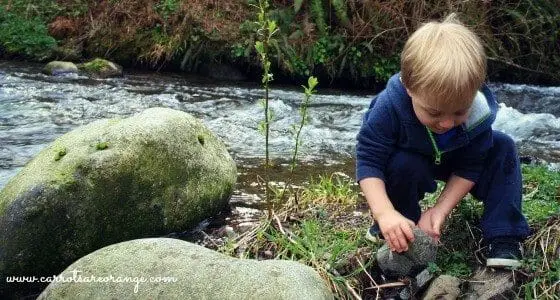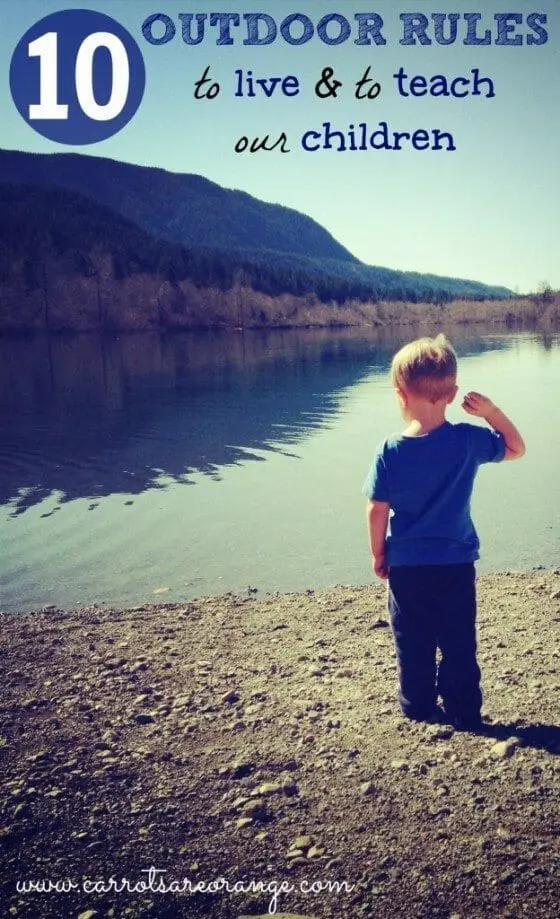Outdoor learning provides a valuable opportunity for children to explore and connect with the natural world. When teaching kids about outdoor learning, it’s important to establish some basic rules to ensure their safety and promote a positive and respectful experience.

“The earth has music for those who listen.” ~ George Santayana
Outdoor Learning Rules to Teach Our Kids
#1 – Go Outside Every Day
Yes, every day. Better yet begin and end the day with fresh air. The best way to wake up and to unwind from the day.
#2 – Do Not be Afraid
Get dirty. Be welcoming of critters. When I heard one of my Montessori instructors say “in order to create a sense of awe and wonder in children, you need to hold back your fears”, my journey to embracing and loving everything about the outdoors began.
I could no longer say, “Oh, gross,” or jump when I saw a spider, or explain my irrational dislike of raccoons in front of my children, at least when they are first discovering the natural world. Embracing and becoming aware of my own fears of the natural world has changed the way I explore the outdoor environment. I am definitely less afraid myself. So it is easy for me to project that onto my children.
#3 – Question & Research
When I did discover these fears of mine, I took it as an opportunity to learn more about the critters. So, I was never really a fan of slugs. I held back, though, and decided, instead to accept that these creatures must exist for a reason and humans should easily be able to co-exist with them.
Sure enough, I was right. As I learned more about slugs and taught my children about slugs, I came to respect their existence on this great earth.
#4 – Respect Nature & Be Kind to ALL Living Things
I used to, without hesitation, stomp my foot down on spiders, beetles, and insects of all kinds. Plants were trampled upon without a second thought. Once I began learning about insects and plants, I truly do begin to respect them.
Teach children to respect and appreciate the natural environment. Encourage them to treat plants, animals, and their habitats with care. Remind them not to harm or disturb living creatures and to avoid picking or damaging plants.
Instruct children to stay on designated paths or trails to avoid trampling vegetation and disrupting ecosystems. Teach them about the importance of preserving natural habitats and respecting private property boundaries.
You want to be kind to them, respect their place on this great earth, care for them, and make space for them. Butterflies and caterpillars are easy to accept. Bees, though, not so much. So, take five minutes to learn about the amazingness of honeybees and you will soon do all you can to make certain these insects live a healthy and prosperous life.
#5 – Explore without Hesitation, Not without Knowledge

The short way of explaining this one is: don’t eat plants you don’t recognize. Exploring without boundaries is a romantic notion but let’s be honest a little education goes a long way.
Understand the area. Learn about the plants and the animals living in the environment.
Then you can be prepared to be safe, to explore with some security, and to treat the area in a way that it needs to be treated, naturally.
“Adopt the pace of nature: her secret is patience.”
Ralph Waldo Emerson
#6 – Take a Wilderness Survival Class
I have not taken a wilderness class myself. Perhaps someday I will do so. For my boys, though, learning “survival” and other outdoor skills is a priority and will be a part of their childhood through nature immersion camps, outdoor education, and the boy scouts.
This learning is not so much about making sure my boys can survive if they are stranded or lost in the woods. More so, by learning these skills, they gain valuable emotional and problem-solving life skills.
How to stay calm.
How to think outside the box.
How to problem solve. They build confidence and security in knowing they can fend for themselves, and that they are truly self-sufficient.
#7 – No Such Thing as Bad Weather, Only Bad Clothing
This saying may seem cliche but it is one to live by day in and day out, especially here in the Pacific Northwest where the weather can paralyze the best of us. Exploring in the off seasons or when the weather challenges us are some of the more extraordinary and interesting times to be outdoors.
Teach children about dressing appropriately for outdoor activities. Encourage them to wear comfortable clothing and appropriate footwear for the weather and terrain. Remind them to apply sunscreen, wear hats, and bring water bottles to stay hydrated.
Practicing this approach from an early age is valuable and life-changing.
#8 – Learn Something New Every Day
We’ve all heard this one but apply it specifically to the outdoor environment whether that something new is a type of bird, a plant in your neighborhood, or a vegetable you want to protect in your garden this year. Maybe even explore a new area of your region.
#9 – Read about Environmental Stewards and Pioneers
Who were they? What inspired them? Why did they have such passion for the environment? There is so much to learn from history and others’ journeys. Let their paths inspire you to want to learn more and to be with the outdoors more.
#10 – Teach Others
One of the most satisfying and gratifying ways to appreciate and love nature is to teach others in your life. I have witnessed my son explain to a friend what insect skates on top of the pond water, then how you can tell how old a tree is by the number of rings in its trunk.
There is joy in his teaching. He sees the face of his friend light up, the eyes of his friend squint with thought and questions.
#11 – Be Mindful of Wildlife
Help children understand the importance of observing wildlife from a safe distance. Encourage them to avoid touching or approaching wild animals, as it may disrupt their natural behaviors and potentially pose a danger.
#12 – Leave No Trace
Teach kids the principles of “Leave No Trace” outdoor ethics. Encourage them to carry out any trash or litter they generate and dispose of it properly. Teach them the importance of keeping natural areas clean and preserving their beauty for others to enjoy.
#13 – Stay Hydrated and Have Snacks
Educate children about the importance of staying hydrated during outdoor activities. Encourage them to drink water regularly and provide them with healthy snacks to maintain their energy levels.
These “rules” are a few I try to live in our home. What about you?
By teaching these outdoor learning rules, children can develop a sense of responsibility and respect for nature while safely enjoying the benefits of outdoor education. It’s important to reinforce these rules regularly and lead by example, demonstrating proper behavior and attitudes toward the environment.


